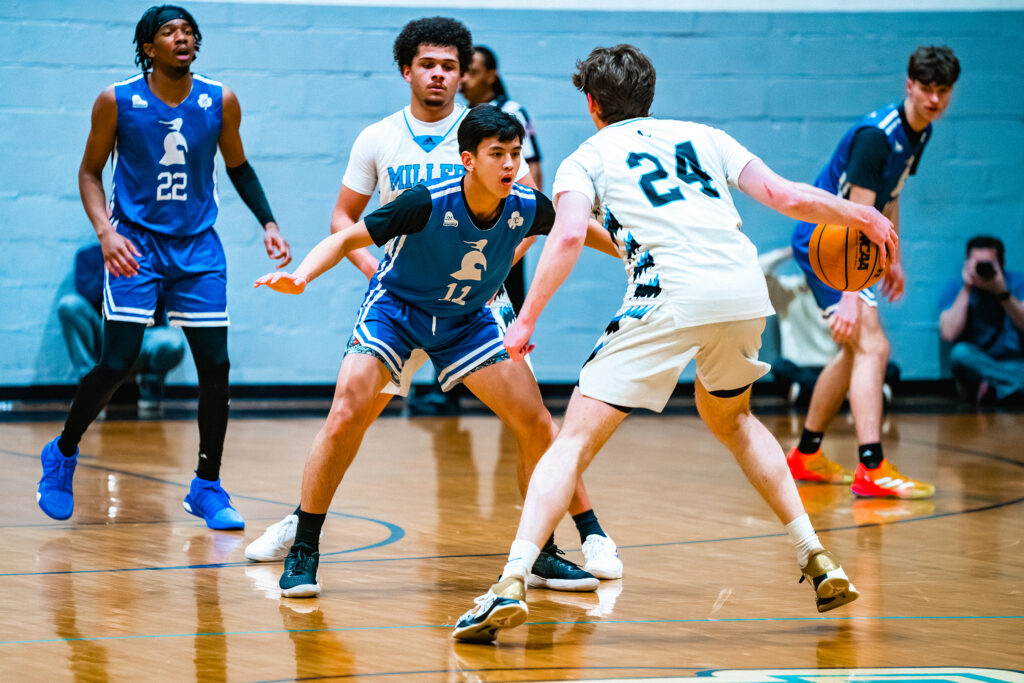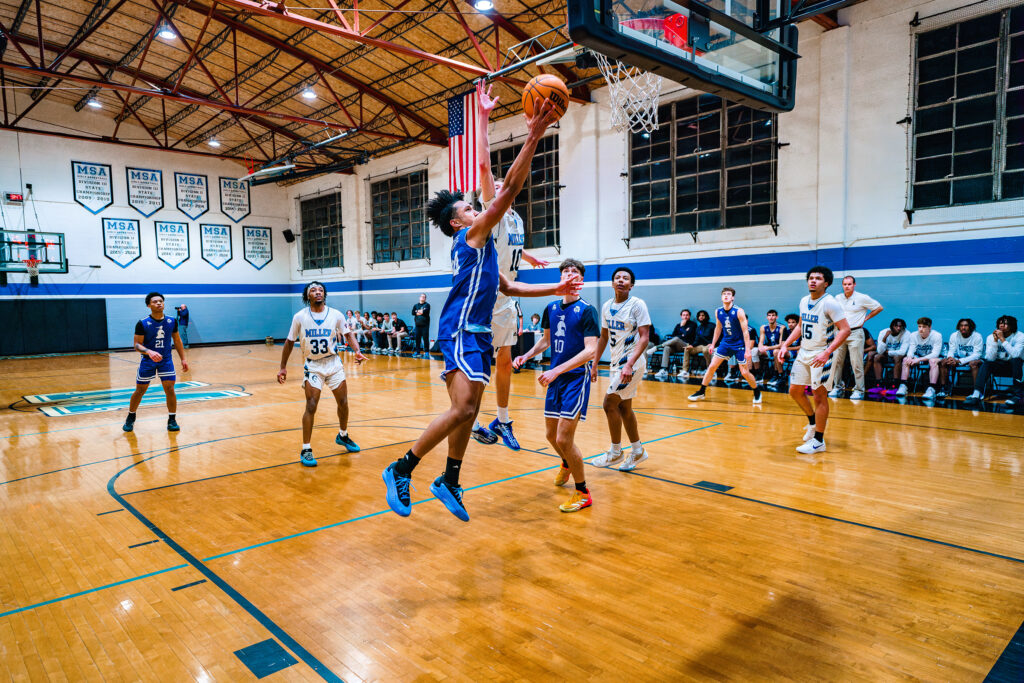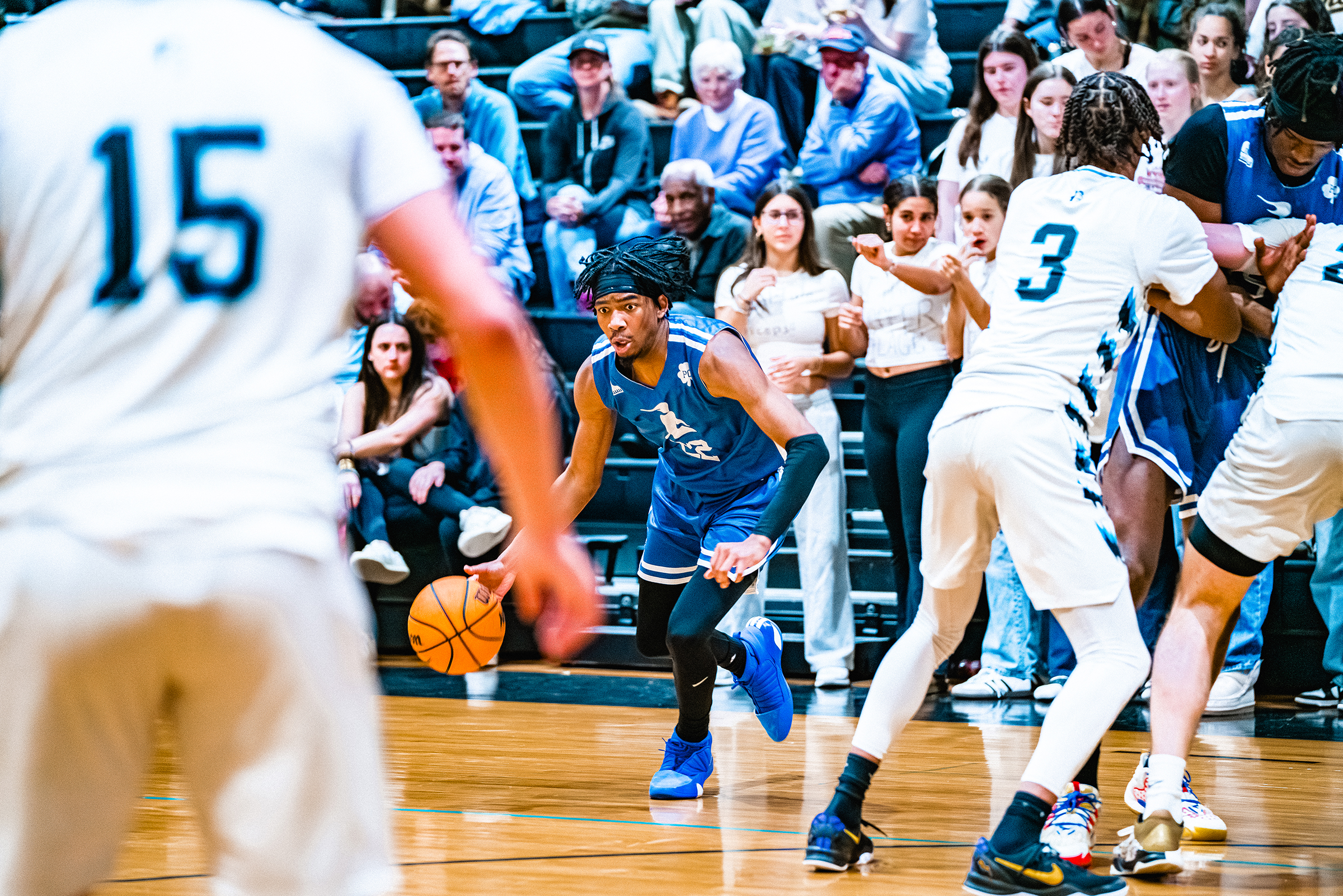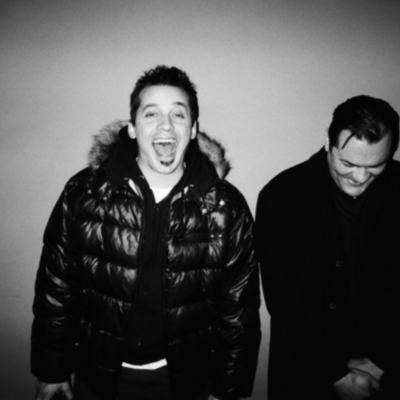The snowstorm brought bad news. Tuesday’s varsity basketball game, which would decide whether the Blue Ridge Barons or Miller School of Albemarle Mavericks would land the No. 1 seed in postseason play, was postponed to Thursday.
For Blue Ridge seniors like Colby White, a 6’3″ guard, the snow delay meant two things. One, White and his teammates would have to sweat for two more days before playing an away game against one of the hottest teams in the Blue Ridge Athletic Conference. Two, Tuesday would be a practice day, rather than a game day.
The Barons’ two returning seniors, White and 6’2″ wing D’Myo Hunter, know what to expect from Head Coach Cade Lemcke’s practices. The workouts focus heavily on most players’ least-favorite part of the game—defense—and they’re only limited in time and intensity by scheduling details like the dining hall closing or study hall opening. Blue Ridge is an all boys’ boarding academy, and members of the school’s proud basketball team never have parents waiting in the parking lot to take them home after practice. They live steps from the gym, steps from the place where Lemcke teaches a brand of basketball as taxing as it is effective.
The Barons have had remarkable success over the past 40 years, winning their first four state championships between 1986 and 2015. Lemcke joined the coaching staff as an assistant for the 2014–2015 state championship season and took over as head coach the next year. Since then, Blue Ridge has more than doubled its championship total, winning five more in ’17, ’19, ’20, ’21, and ’22. The dominant stretch since Lemcke arrived has produced 21 Division I NCAA basketball talents, including Mamadi Diakite, who helped the University of Virginia win its 2019 national championship, and Aamir Simms, an all-conference player at Clemson University.
“I’ve gotten to coach these players from not only all over the United States, but the world,” Lemcke says. “Almost all of them are in it for a similar goal. They want to play at the next level, to maximize what God has given them, and to do it in a way that is team first.”
Industrial to industrious
The Blue Ridge School opened in 1909 in St. George, a 40-minute drive on state and county roads from Charlottesville. The school was originally an industrial education center, a place where young people from the surrounding towns could commute for days at a time to learn the trades that would help them thrive in the Shenandoah mountains.
In the late 1950s, public school and transportation infrastructure expansion brought Blue Ridge to a crossroads. To remain relevant, it would have to be something other than an industrial school—a community college, a seminary, or, perhaps, a boys college preparatory.
Administrators went the third route, and the new prep school opened in 1962 with 66 students. Blue Ridge quickly grew its reputation academically and athletically, the latter mostly on the back of its wrestling program. Football and basketball took hold slowly, and by the late 1980s, the school was on the map for young men seeking a place where they could isolate themselves and focus on their dreams in the classroom and on the basketball court.
Coach Bill Ramsey took the hardwood helm in 1996 and brought Blue Ridge back-to-back state championships in 2000 and 2001. Lemcke says that under Ramsey, he learned much about the traditions and expectations at Blue Ridge, not only on the basketball court but in a fully immersive community where the coaches and players spend nearly all their time together on the small, rural campus.
“I had heard about Blue Ridge, but I had not been engrossed in the culture,” Lemcke says. “It was a great opportunity for my family and I.”
Coach Cade
Lemcke grew up the son of a basketball coach in Rochester, New York. He looks the part. Gritty and earnest with close-cropped hair and a furrowed brow, he speaks quickly in his slight upstate-New York accent.
As a boy, the gym was where Lemcke spent time with his dad, watching the coach mold young men and gaining an abiding love for basketball. Lemcke had success as a player as well. He won a state championship with his all-boys high school, McQuaid Jesuit, in 1988. A 6’6″ guard, Lemcke says he was never the most athletic player on the court, but he had the high basketball IQ he honed at his father’s side. He was recruited by UVA coach Pete Gillen, and his college years reinforced what he knew: Hard work would drive any success he had in the game he loved.
Lemcke’s playing career ended in 2002. He married his college sweetheart, and the couple decided to stay in the area. As an entrepreneur drawing on his training from the university’s McIntire School of Commerce, Lemcke launched a small business and an AAU basketball program, East Coast Fusion. The hoops organization grew, as did Lemcke’s reputation as a coach and leader.
Lemcke drew the attention of the Longwood University basketball team in 2013. He traveled south to be the school’s assistant coach for one season before he had the opportunity to be Ramsey’s heir apparent at Blue Ridge. There, he would also expand his work with young people as director of special programs, math teacher, and head of the Fellowship of Christian Athletes.
Along the way, Lemcke made another formative stop in Charlottesville that would impact the coaching style he’d bring to Blue Ridge hoops. Serving as director of finance at the John Paul Jones Arena, he had a daily front-row seat for UVA basketball practices led by coach Tony Bennett.
“They say that when you go from being a player to a coach, you end up coaching the areas that you were weak in,” Lemcke says. “One of the things I was poor at as a player was defense.”

Gray’s pitch
It was January 22, and Blue Ridge Barons assistant coach Rob Gray was feeling good about the team’s season. The Barons were undefeated at 21-0 and ranked in the national top 50. They were on track to win the Blue Ridge Athletic Conference and enter the postseason tournament as the No. 1 seed. Another state championship was by no means out of the question.
Just over a week prior, on January 14, the Virginia Independent Schools Athletic Association had released its latest boys basketball state poll, and Blue Ridge captured the Division I top ranking with 115 votes.
Gray, co-founder of the Charlottesville-based Uhuru Foundation, which helps young people and troubled adults with life coaching and basic needs, decided to take a shot. “We’re having a great season out here,” he said in an email. “Come have a look at us.”
Sports, of course, have a way of beguiling.
The Barons would lose their next two games, one an overtime heartbreaker. Then, after stringing together two more wins, they lost a third game, this one a buzzer-beater gut punch by rival St. Anne’s-Belfield.
By the time they were set for their snow-delayed matchup on February 13 against the Miller School, VISAA’s top-ranked Division II team, the Blue Ridge boys were 24-3—no longer undefeated, but still in a good position to grab the top BRAC seed as they started their conference tourney and made a run at Lemcke’s sixth state championship.
The head coach was, frankly, surprised. He had entered the season expecting something of a rebuilding year. The Barons had only five seniors, three of whom were new to the varsity squad. They had a glut of talent at the third-year level; next season, Lemcke figured, would probably be the one.
A recognizable scheme
Gray, now in his second year on the Blue Ridge basketball staff, is one of four assistants to Lemcke. “One of the big secret sauces that we have is our coaching staff,” Lemcke says. “I would put our coaches up against anybody in high school basketball.”
In addition to Gray, who Lemcke coached at the AAU level, the staff consists of Associate Head Coach Tladi Conway, Assistant Coach and Blue Ridge Athletic Director Parker Kirwan, and Assistant Coach Johnny Atkinson, who finished his playing time at Blue Ridge under Ramsey.
Conway and Kirwan are full-time assistants and live on campus with Lemcke and the rest of the Blue Ridge community. Gray and Atkinson are part-time assistants. Over the past decade, Lemcke has worked with only a few other assistants—all of whom he says have been critical to the program’s success.
“There’s a cliché out there that it’s not about the Xs and the Os but the Jimmies and the Joes,” Lemcke says. “It’s your ability to connect with your athletes and earn their trust. I have been so blessed to have these coaches through my 10 years here. They know the game, but they really know people.”
What Lemcke asks of his people—his players—is effort. In a game where young stars want to score the basketball more than anything, the head ball coach demands his players focus on the defensive end. His teams play man-to-man 100 percent of the time; they never deploy a zone, which can give players a chance to rest when they’re away from the ball.
Lemcke’s scheme is meticulously designed to make sure opposing teams never get an easy look at the basket. Every shot should be contested. Every game should be a low-scoring, high-intensity grind.
In other words, every game should look a lot like it’s being played by a Tony Bennett-led Cavaliers team. Bennett’s squads were the best in the Atlantic Coast Conference at limiting opponent scoring from 2012 to 2024. They were the best in NCAA Division I at limiting opponent scoring from 2017 to 2020.
In the first 24 games the Barons won this year, they allowed their opponents to score more than 60 points only five times. And on January 9, the first time Blue Ridge faced the Miller School, the Barons’ stingy D held the Mavericks to only 41 en route to a 24-point victory.
Tip off
Lemcke knew his team had a tough road ahead as it prepared for the MSA matchup. He knew the players were succeeding mostly through pure grit, determination, and discipline. The Barons were winning close games, and every time they needed it, seniors White and Hunter were making plays.
What’s more, everyone in the conference knows about Blue Ridge. They know how successful the basketball team has been. “When you wear this Blue Ridge School uniform, you are going to get everyone’s best game,” Lemcke says. “You need to be ready to be on that stage.”
For Lemcke, the remarkable thing about this season has been the ability of his players, with only two returning seniors, to come together. On the offensive side of the ball, the Barons are a foil to their defense. Because Lemcke demands discipline on one end, he allows freedom on the other. Blue Ridge’s offense is dependent on every individual knowing the game inside and out and how to play on and off the ball—when to cut, when to slash, when to pass, when to shoot. In other words, everyone has to know what their teammates are going to do before they do it.
It all came together in their first matchup against the Miller School. The 65-41 box score looked like so many UVA wins during Bennett’s most dominant stretches—just the way Lemcke draws it up.
But MSA was seemingly a different team just over a month later. The Mavericks came into the February 13 game against the Barons having won five straight and outscoring opponents by more than 50 points on average.
From the first tip, the Barons’ defense managed to do what they’re known to do. They played lockdown man-to-man, contested every shot, and held MSA to 22 points in the first half. They went to the locker room up 25-22.
At halftime, Coach Cade presumably told his team to stay the course. Keep contesting shots. Keep giving 100 percent on defense and anticipating your teammates moves on offense. Play together for two more quarters, and you’re conference champs.
The Mavericks started the third quarter shooting lights out. They scored 11 unanswered points to go up 33-25. White and Hunter did their part on offense, with White putting up a team high 23 points. But the defense faltered. It couldn’t get a stop when the team needed one. The Barons allowed 47 points in the second half and fell to MSA 69-54.

Work left to do
A loss to the Miller School, which won a state championship in 2018 and has sent its own share of players to NCAA Division I basketball teams, is no reason to call off a season.
“I mean, it happens, right? It happens to great teams,” Gray says. “We got a little lackadaisical and lost focus, and that’s something we have been preaching—stringing four quarters together consecutively and staying locked in and focused throughout.”
Blue Ridge will enter the BRAC postseason tournament as the two seed. The Barons will play their semifinal game on February 20 and, with a win, advance to the finals two days later. The VISAA Division I state tournament begins February 25.
Winning the tournament won’t be easy, Lemcke says. He calls this one of the deepest VISAA state tournaments in history, with at least six teams in a position to claim the title.
However it turns out, he doesn’t plan to judge his success based on the 2025 state tournament.
“I won’t know if we’ve done a good job coaching these young men for 10, 20, 30 years after they leave us,” he says. “Then you can see if that time we spent with them was impactful. If we can impact these young men’s lives, that is what we love. It’s just that the vehicle for me is basketball.”






